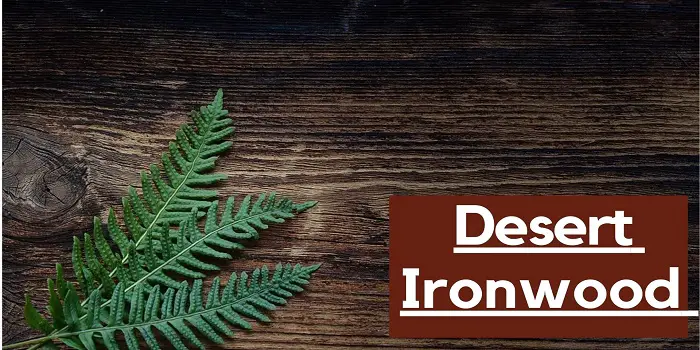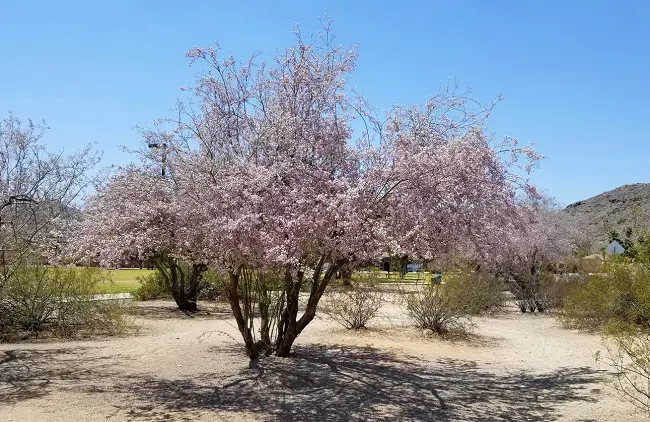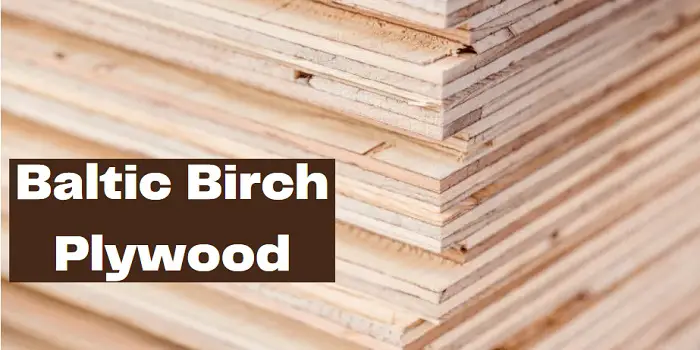
The Desert Ironwood (Olneya Tesota) is unlike any other tree you will find.
Technically, it isn’t even a tree. Instead, it’s a leguminous tree part of the same Fabaceae family that has the more common peanut, soybean, and green bean.
It retains the characteristic seed pod for germination and distribution.
To make this tree even more unique, the Desert Ironwood is found in one area only.
Growing exclusively along the California and Mexico border, these evergreen trees live long lives in harsh climates and have been a cultural staple for the indigenous populations.
If you are interested in knowing more about it, let’s dig into their background use more…
Desert Ironwood
| Scientific Name: | Olneya tesota |
| Tree Size: | 20-30 ft (6-10 m) tall 1-2 ft (.3-.6 m) trunk diameter |
| Janka Hardness: | 3,260 lbf (14,500 N) |
| Type: | Hardwood |
| Odor: | Unpleasant smell |
| Specific Gravity (Basic, 12% MC): | ~.97, ~1.21 |
| Common Uses: | Knife handles and carvings |
Ironwood Anatomy
The anatomy of common trees consists of a trunk, limbs, leaves, and concentric interior rings showing age.
Comparatively, Ironwood is similar, but not exactly. The unique setting for the tree makes the wood highly sought after and valuable.
Habitat
As mentioned above, the Desert Ironwood grows exclusively along the US and Mexico border, specifically along the southern edge of California and Arizona.
When mapped, the tree’s current extent matches precisely within the boundaries of the Sonoran Desert. This makes the Ironwood exclusively found in a single environmentally distinct region.
The Ironwood is usually only found below 2,500 feet and, more specifically, at the bottom of dry river washes where frost and freezing temperatures are rare.
These trees have inhabited this region for hundreds of years.
Some trees have been identified as being at least 800 years old, making them the “old-growth” desert tree for the Sonoran Desert.
Ironwood Appearance
Standing upwards of 35 feet, the Desert Ironwood grows slowly in a dry climate with little rain.
However, as it often is found in ephemeral riverbeds, it does have water available during the wet season.
The trunk thickness tends to be only a foot or more, but the canopy of the limbs and leaves gives it a breath as wide as tall.
Starting in March, the tree limbs bud out, becoming pink, white, and lavender-colored flowers. By the middle of summer, the flowers grow into seed pods.
Each seedpod is hairy and about 2 inches long, containing one to four brown seeds.
Because it is in the legume family, the leaf litter is vital to the health of the soil below due to the high concentrations of nitrogen.
In addition, the slow growth rate in an arid climate has caused this evergreen tree to have highly dense wood that sinks in water.
The wood is dense enough to keep birds from nesting inside holes or knots.
Threatened Status
Due to overuse and deforestation, the Desert Ironwood has been slowly decreasing in population size and coverage.
Further, because of the slow growth rate of the tree, repopulation is difficult.
Neither California nor Mexico considers this tree threatened or endangered.
However, the tree is slightly protected in Arizona. The plant laws restrict Ironwood from being transported but do not require preservation of any kind.

Uses Of Desert Ironwood
Ironwood’s unique density, shown in its inability to float, gives it many uses by the local population and others around the world.
However, the benefits have changed mainly due to increased access to woodworking machinery and bulk transportation.
Here is a quick history of the local uses for this indigenous legume.
Past Cultural Uses
Traditionally the local indigenous populations used only the renewable parts of Ironwood. This included the leaves, flowers, seedpods, and only deadwood.
No living trees were used to save the trees from extinction.
Instead, populations and communities used the tree’s resources for medicine, food, household implements, and ceremonial items.
The coastal community of the Seri people carved creative renditions of local animals out of dried dead Ironwood to sell to travelers and tourists.
Unfortunately, other Mexican communities copied this practice leading to the annihilation of much of the population of Ironwood trees.
Current Uses
With the advent and common use of forestry machinery, Ironwood became a standard charcoal export.
Due to its dense nature, the Ironwood material burns extra hot, more than other comparable charcoal utility trees.
Luckily, the Mexican government outlaws permit for cutting Ironwood for charcoal production, but enforcement can be difficult at best.
When used sparingly, the Ironwood makes an excellent block for handles of any utensil, particularly knives.
The rugged and dense wood has intricated and beautiful ribbons of rings through any cut.
It can be used successfully even in the most arduous of conditions.
Characteristics Of Desert Ironwood
Desert Ironwood is not uniform in color, grain, or texture. Instead, its age and exposure to moisture make each cut unique and incredibly appealing.
Here are a few key features to be found when using Ironwood for woodworking projects.
The color and appearance of the heartwood vary from a deep brown or red to a lovely orange with yellow tones.
Ironwood grows with a gnarly and wild grain, but its density creates a fine texture and silky natural luster.
Due to its density and weight, the wood fits best for small woodworking projects, takes a polish, and finishes well.
However, the wood is surprisingly unpleasant to smell when working with, and the sawdust can cause irritation to the skin. This is due to high levels of toxins in the wood.
Desert Ironwood – A Keystone Species
The Desert Ironwood is a keystone species that has helped the desert thrive for over a thousand years.
The slow growth rate and wide canopy shelters the desert pavement below.
The canopy cools the ground during the day and keeps the warmth overnight.
This has led many to consider the tree a nursery tree for the early growth stages of other plants.
Over 230 plant species use the Ironwood canopy as a place to sprout.
Further, the leaved limbs, summer seeds, and nitrogen-rich leaves are home to over 150 birds, 60 species of reptiles, and 64 species of mammals.
During the summer, the Ironwood drops its seed pods entirely edible and available during a season with very limited water and food for the animal community.
Is Black Ironwood the Same as Desert Ironwood?
No, both these wood are different and differ in characteristics like Janka hardness, odor, color (heartwood as well as sapwood), and others.
While both the woods are highly dense and are difficult to work with, Black ironwood is harder and denser, with a Janka rating of 3,660 lbf (16,280 N), whereas desert ironwood has a rating of 3,260 lbf (14,500 N).
When machined, Desert Ironwood has a distinct and somewhat noxious odor. But Black ironwood has no characteristic odor and is relatively easier to work.

Hi, I am Mark Garner a professional carpenter, woodworker, and DIY painter. I live in the small city of Peoria, Arizona as a semi-retired woodworker. I have started this blog with a simple motive to help you with my wood experience in this sector. If you like to know more about what I love doing and how it all got started, you can check more about me here.




